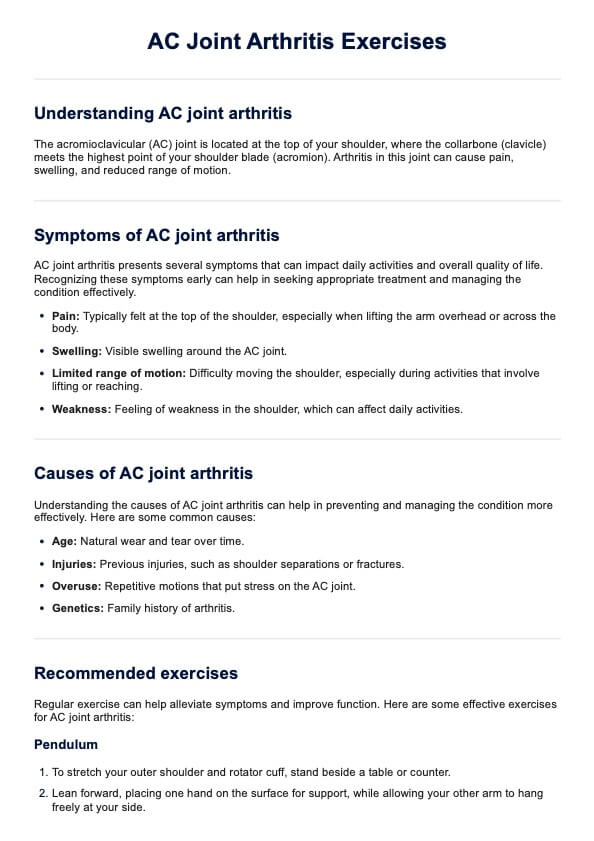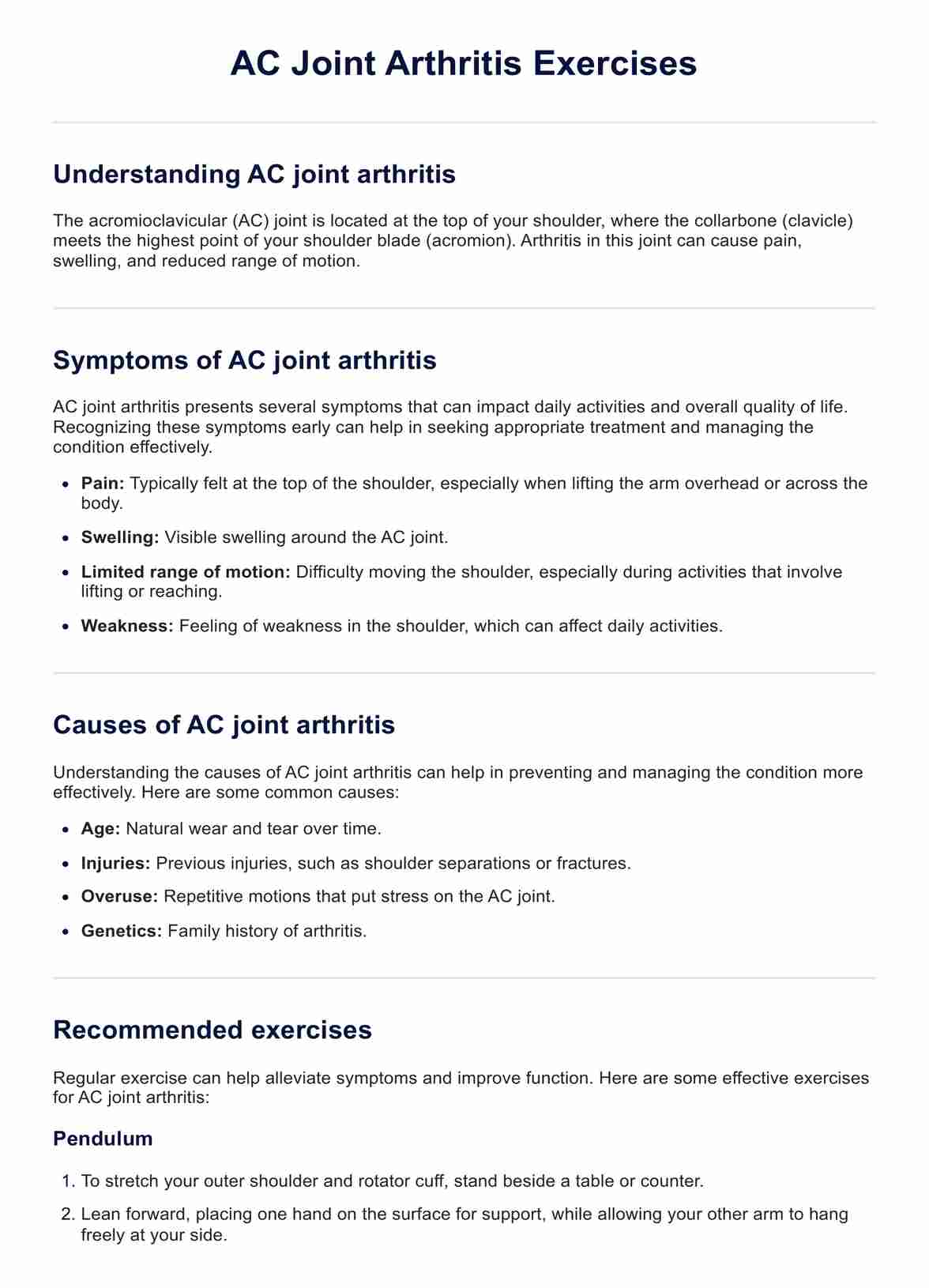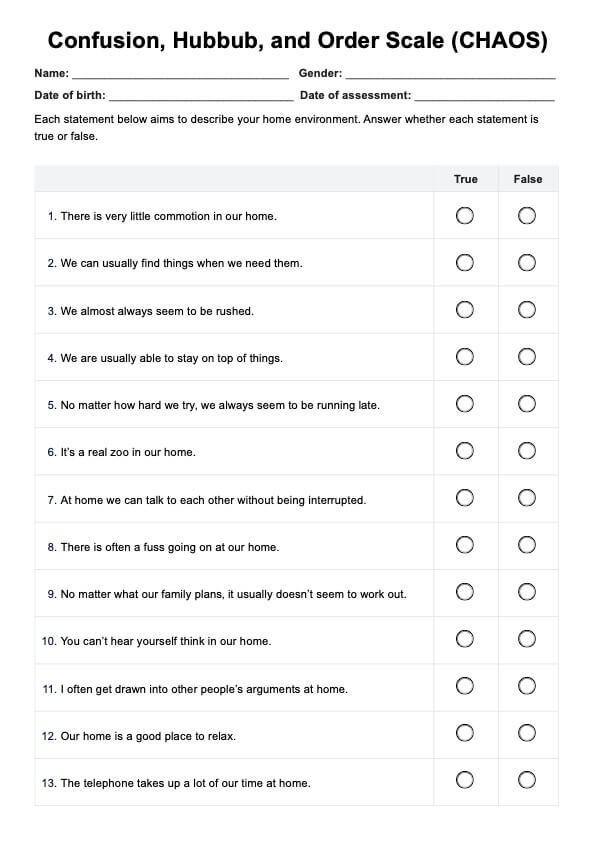AC Joint Arthritis Exercises Handout
Enhance patient care with our AC Joint Arthritis Exercises Handout. Learn about effective exercises, benefits, and why Carepatron is the ideal physical therapy software.


What is AC joint arthritis?
AC joint arthritis, or acromioclavicular joint arthritis, is when the joint connecting the collarbone (clavicle) to the shoulder blade (acromion) becomes inflamed and degenerates. This condition often results from the natural wear and tear of the joint over time, past injuries, or repetitive stress on the shoulder joints.
Common symptoms include shoulder pain, particularly when lifting the arm or carrying heavy objects, swelling, tenderness, and reduced range of motion. Causes typically include aging, previous shoulder injuries, overuse from activities that strain the shoulder, and genetic factors.
AC Joint Arthritis Exercises Handout Template
AC Joint Arthritis Exercises Handout Example
How physical therapists address AC joint arthritis
Physical therapists are crucial in managing AC joint arthritis by creating personalized exercise programs to strengthen shoulder muscles, improve flexibility, and reduce pain. They employ manual therapy, stretching exercises, and modalities like heat or ice therapy to alleviate symptoms and enhance shoulder joint and function.
Additionally, physical therapists educate patients on proper posture, ergonomics, and activity modifications to prevent further strain on the shoulder. Through regular therapy sessions, patients often achieve better shoulder stability, increased range of motion, and overall improved function.
How exercises help AC joint arthritis
Exercises are fundamental in managing AC joint arthritis. Strengthening exercises support the shoulder muscles, reducing strain on the joint and alleviating shoulder arthritis symptoms. Stretching exercises enhance flexibility, allowing for a greater range of motion and reducing stiffness. Regular physical activity also promotes circulation, which helps reduce inflammation and pain.
By integrating these exercises into their routine, patients can experience significant improvements in pain levels, shoulder function, and overall quality of life. A well-rounded exercise program tailored to individual needs can effectively manage symptoms and prevent further joint deterioration.
6 examples of AC joint arthritis exercises
Regular exercise can be crucial in managing AC joint arthritis, alleviating symptoms, and improving overall function. Here are six effective exercises that healthcare professionals can teach their patients to help manage this condition:
Pendulum
Pendulum exercises are designed to stretch the outer shoulder and rotator cuff, reducing stiffness and enhancing mobility. Instruct patients to stand next to a table or counter and lean forward, placing one hand on the table for support. Their other arm should hang freely, and they should gently swing it forward and back, then side to side, and finally, in a circular motion.
Repeat the sequence with the other arm, ensuring the patient avoids rounding their back or locking their knees.
Crossover arm stretch
This exercise targets the back of the affected arm below the shoulder, improving flexibility and reducing discomfort. Advise patients to stand straight with relaxed shoulders and pull one arm across their chest, holding at the upper arm. They should hold this position for 30 seconds, then relax and repeat with the other arm.
Recommend performing the sequence three more times, cautioning against pulling or putting pressure on the elbow.
Passive internal rotation
Passive internal rotation stretches the front of the shoulder, enhancing the range of motion. Instruct patients to use a lightweight stick like a yardstick or cane. They should hold the stick behind their back with one hand, lightly grasping the other end with the other hand, and pull the stick horizontally to feel a stretch in the front of their shoulder. They should hold for 30 seconds, relax, and repeat on the other side.
Recommend performing the sequence three more times, advising them to avoid leaning over or twisting to the side while pulling the stick.
Passive external rotation
This exercise stretches the back of the shoulder, alleviating stiffness and improving flexibility. Have patients use a lightweight stick, grasping the stick with one hand and cupping the other end with the other hand, keeping the elbow of the stretching shoulder against their body. They should push the stick horizontally to feel a stretch in the muscles surrounding the back of their shoulder, hold for 30 seconds, relax, and repeat on the other side.
Recommend performing the sequence thrice, ensuring their hips face forward without twisting.
Wall crawl
Wall crawl exercises improve the range of motion and strengthen shoulder muscles. Advise patients to stand in front of a wall at arm's length and slowly crawl their fingers up the wall as high as comfortably possible. They should hold for 15 to 30 seconds, then crawl back down.
Recommend repeating one or two more times, encouraging them to reach higher each time. They should pause and focus on relaxing their shoulder blades and muscles if they feel pain or tightness.
Wall push-up
Wall push-ups strengthen the shoulder, arm, and chest muscles. Instruct patients to stand in front of a wall with their arms straight and hands flat against it, placing their feet slightly wider than shoulder-width apart. They should tighten their stomach muscles, bend their elbows, lower their upper body toward the wall, hold for one second, and then push back until their arms are straight.
Recommend repeating eight times, gradually increasing reps. Ensure they keep their fingers flat against the wall to thoroughly engage their shoulder, upper arm bone, and chest muscles.
How our AC Joint Arthritis Exercises Handout works
This handout is designed to provide patients with a comprehensive guide to understanding and managing AC joint arthritis through targeted exercises and practical tips. Follow these steps to use the handout effectively:
Step 1: Download the handout
Get a copy of the AC Joint Arthritis Exercises Handout using the link on this page or via the Carepatron app. It's also available from our resources library.
Step 2: Give your patient a copy
Once you have downloaded the handout, give a printed copy to your patient or send it electronically. Explain how the handout is designed to help them manage their AC joint arthritis and encourage them to read through it carefully.
Step 3: Encourage regular exercise
Regular exercise is crucial for managing AC joint arthritis. The handout offers a range of exercises that focus on strengthening the surrounding muscles, improving range of motion, and reducing pain. Encourage your patient to incorporate these exercises into their daily routine.
Step 4: Emphasize proper form
Proper form is essential when performing any exercise, especially for those with joint conditions like AC joint arthritis. Encourage your patient to pay attention to the instructions in the handout and to consult with you if they have any questions about proper form.
Step 5: Share practical tips
In addition to the handouts, give your patients practical tips to help them manage their condition. This could include advice on posture, using ice or heat therapy, and taking breaks during activities that put strain on the AC joint.
Benefits of using this handout
Providing patients with a comprehensive and informative handout on AC Joint Arthritis Exercises offers numerous benefits. These handouts are valuable tools for healthcare professionals, enhancing patient education, compliance, and overall care outcomes. Here are three key benefits of using this handout:
Improved patient understanding
Handouts provide clear, concise information about AC joint arthritis, helping patients understand their condition, symptoms, and the importance of exercise. When well-informed, patients are more likely to follow through with prescribed treatments and exercises, leading to better management of their condition.
Enhanced patient compliance
A detailed handout with step-by-step instructions encourages patients to adhere to their exercise regimen. This consistency in performing recommended shoulder exercises can significantly improve joint mobility, reduce pain, and enhance overall shoulder function, leading to more favorable treatment outcomes.
Streamlined communication
Handouts facilitate effective communication between healthcare providers and patients. By providing written instructions and visual aids, healthcare professionals can ensure patients have a reference to follow at home. This reduces the need for repeated explanations and helps patients stay on track with their treatment plans.
Commonly asked questions
AC joint arthritis is primarily caused by wear and tear on the joint, often due to repetitive overhead movements, previous joint injuries, or aging. It can also result from conditions such as osteoarthritis or rheumatoid arthritis.
AC joint arthritis is typically diagnosed through patient history, physical examination, and imaging tests such as X-rays or MRIs. These tools help healthcare providers assess joint damage and inflammation.
Treatment options for AC joint arthritis include physical therapy, medications for pain and inflammation, lifestyle modifications, and, in severe cases, surgical intervention. Exercise is critical to managing ac joint injury symptoms and improving joint function.







































































































